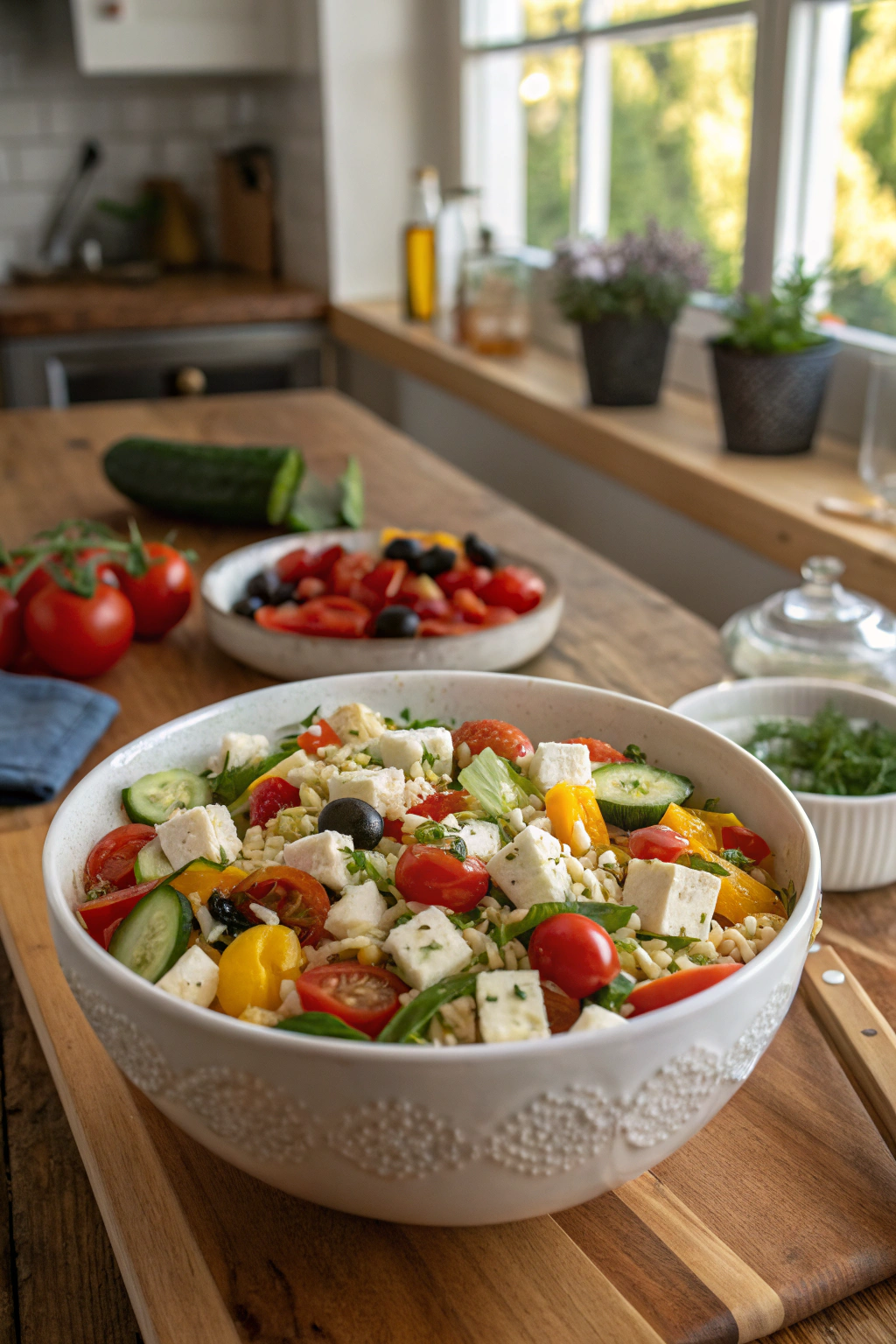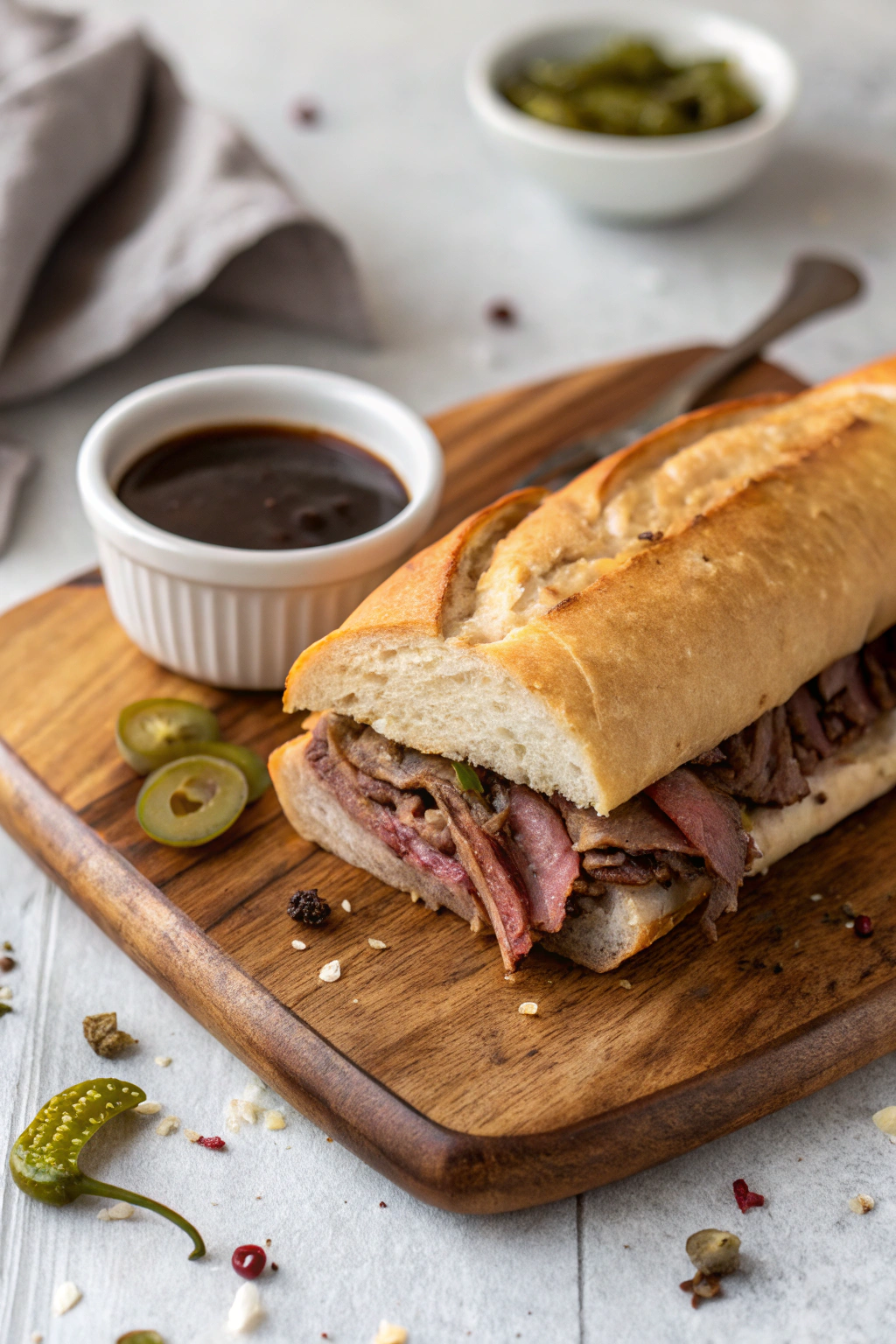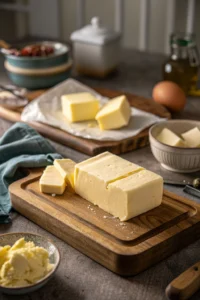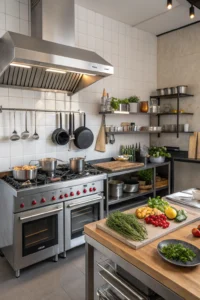Ever wondered how to keep those crisp, aromatic onions fresh for weeks? As a home cook who goes through pounds of onions monthly, I’ve mastered the art of storing these kitchen essentials. Whether you’re dealing with sweet Vidalias or pungent red onions, proper storage is crucial for maintaining their flavor and preventing sprouting.
The key to successfully store onions lies in creating the right environment. Cool, dark, and well-ventilated spaces work best. I’ve learned this through years of trial and error in my own kitchen, and now I’m excited to share these time-tested methods with you.
Why Proper Onion Storage Matters ?
Different Types of Onions & Their Storage Needs
Yellow onions need the driest conditions to store onions successfully. These kitchen workhorses can last up to six months when kept at 45-55°F with 65-70% humidity. Red onions, while equally hardy, prefer slightly cooler spots around 40-45°F. Sweet onions like Vidalias are the divas – they’re more delicate and have higher water content, so they’ll only keep for about a month, even in perfect conditions.
I’ve found that pearl onions need extra TLC – their small size makes them prone to drying out faster. Keep these tiny gems in a paper bag in your crisper drawer. Shallots, though technically not onions, follow similar rules but need checking weekly for soft spots. Green onions are the exception to our dry storage rule – wrap them in slightly damp paper towels and refrigerate.
Science Behind Onion Preservation
Have you ever wondered why onions make us cry when we store them wrong? The science behind proper onion storage actually comes down to their unique cellular structure. When you store onions, they’re still alive and breathing! These remarkable vegetables take in oxygen and release carbon dioxide through their papery skins. That’s why airflow is crucial – without it, they’ll suffocate and rot.
Think of those mesh bags at the grocery store; they’re not just for show! I’ve learned through trial and error that plastic bags are absolute onion killers. The trapped moisture becomes a breeding ground for mold. Temperature also plays a fascinating role in the chemistry of onion storage. When it’s too warm, the sulfur compounds that give onions their bite break down faster, triggering early sprouting. That’s why my grandmother always said, “Keep ’em cool, dark, and breathing!”
Impact on Flavor & Shelf Life
When you store onions correctly, you’re not just preventing spoilage – you’re protecting their distinctive taste! I’ve noticed that properly stored onions maintain their sharp, zesty kick for up to three months. However, one wrong move can turn them mushy and bitter within days. The key lies in choosing the right companions for your onions.
Keep them away from potatoes, which release gases that speed up onion deterioration. Apples and pears are also no-go neighbors, as their ethylene emissions can trigger premature sprouting. I learned this the hard way last fall when my entire batch went soft after storing them next to my apple harvest!
For maximum flavor retention, arrange them in a single layer, making sure they don’t touch each other. Those little gaps between each onion create perfect mini-climate zones that preserve their natural oils and robust flavor profile.
Complete Storage Process from Start to Finish
Selecting & Sorting Your Onions
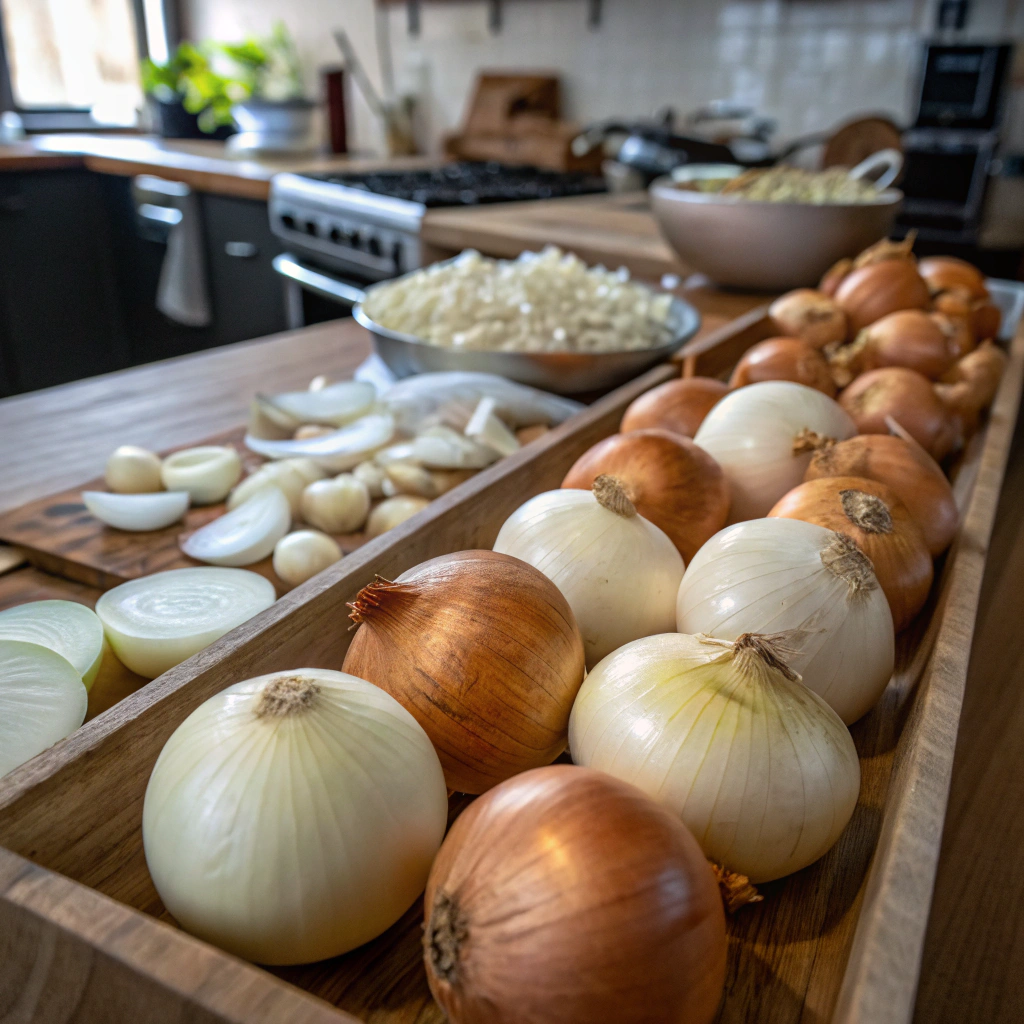
Before diving into storage methods, mastering the selection process is crucial. Pick firm onions with crisp, papery skins – these are your prime candidates for long-term storage. Give each one a gentle squeeze; they should feel solid without soft spots. I always check the neck area carefully – it should be tightly closed and dry. Avoid any onions showing green sprouts or those with dark patches.
Sort your onions by size, as this affects their storage duration. Larger onions typically last longer than smaller ones. I’ve found that medium-sized onions are perfect for most cooking needs and store beautifully. Remember to remove any that show even slight damage, as these can affect nearby onions.
Through years of experience, I’ve learned that taking extra time during selection saves countless headaches later. Store potatoes like a pro using similar inspection techniques for optimal pantry organization.
Best Storage Locations for Maximum Freshness
The right storage spot makes all the difference for onion longevity. Cool, dark, and dry places work best – think pantry shelves or unheated basements where temps stay between 40-50°F. I keep mine in mesh bags or baskets that allow air flow. Never store onions in plastic bags, as they need to breathe!
The fridge isn’t ideal for whole onions since humidity promotes sprouting, but cut onions should definitely go there in airtight containers. Keep onions away from potatoes – they release gases that speed up sprouting in each other.
My favorite spot is a dedicated drawer in my kitchen cabinet with some holes drilled for ventilation. If you have a root cellar, that’s storage gold! Just remember to check occasionally for any that might be starting to soften. A well-ventilated spot can keep onions fresh for 2-3 months.
Troubleshooting Common Onion Storage Problems
Every onion storage journey has its challenges, but they’re easy to overcome with the right know-how. Watch out for those pesky soft spots – they’re usually the first sign something’s not quite right. If you notice sprouting, your storage space might be too warm or humid.
I’ve found that black mold is often caused by moisture trapped against the onion skin. When onions start getting mushy bottoms, they’re probably sitting in a spot with poor air circulation. The biggest mistake I see? Keeping onions in plastic bags from the store. Transfer them to mesh bags right away!
For green shoots, simply trim them off – the onion is still good to use. Remember to check your stored onions weekly and remove any that show signs of spoilage. Quick action can save your whole batch from going bad. Just keep in mind that even perfectly stored onions will eventually sprout – it’s their natural cycle.
Professional Storage Secrets Revealed
Temperature & Humidity Control
Mastering onion storage starts with getting the temperature and humidity just right. The sweet spot? Keep them between 40-50°F with 65-70% humidity. Your garage or basement might work perfectly during cooler months. But here’s a game-changing tip – avoid the fridge unless they’re already cut! The high moisture inside can make them mushy fast.
I’ve found that a wire basket in a cool, dry corner of my pantry works wonders. Add a small fan nearby for better air circulation if needed. Those mesh bags from the store? They’re actually perfect for this! Just hang them where air can flow freely.
Watch out for warm spots near your stove or dishwasher – they’ll trigger sprouting faster than you can say “onion soup.” Remember, consistency is key. Once you find that perfect spot, stick with it!
Proper Preparation Methods
Preparing onions before storage is crucial for maximum freshness. Start by gently brushing off loose dirt – but don’t wash them! Moisture is the enemy here. Trim those roots and stems, leaving about an inch of the neck intact. Check each onion carefully, removing any that show signs of damage or soft spots. Those damaged ones? Use them first!
A quick tip I learned from my grandmother – let them “cure” by spreading them out in a single layer for 24 hours before storing. This helps their outer skins dry completely. For the best results, only store onions that feel firm and have tight, crispy skins.
And here’s something most people miss – remove any plastic packaging or rubber bands. Those can trap moisture and speed up spoilage. Remember, a little prep work now means longer-lasting onions later!
Best Storage Locations
Your kitchen’s layout plays a huge role in keeping onions fresh. The ideal spot? A cool, dark pantry or cabinet away from direct sunlight. I’ve found that mesh bags work wonders – they let air circulate while keeping things organized. The temperature sweet spot is between 45-55°F (7-13°C). Basements can work great too, just avoid anywhere too humid.
A common mistake? Storing near potatoes – they’ll make each other spoil faster! Speaking of no-nos, keep those onions away from your fridge. The humidity in there is way too high and will turn them mushy quick. Counter space might be tempting, but sunlight’s not your friend here.
Got a garage? That could work in cooler months, but watch those temperature swings. Remember, wherever you choose, good ventilation is key. Your onions should be able to “breathe” – it makes all the difference in extending their shelf life.
Fixing Common Storage Problems
Preventing Sprouting & Rotting
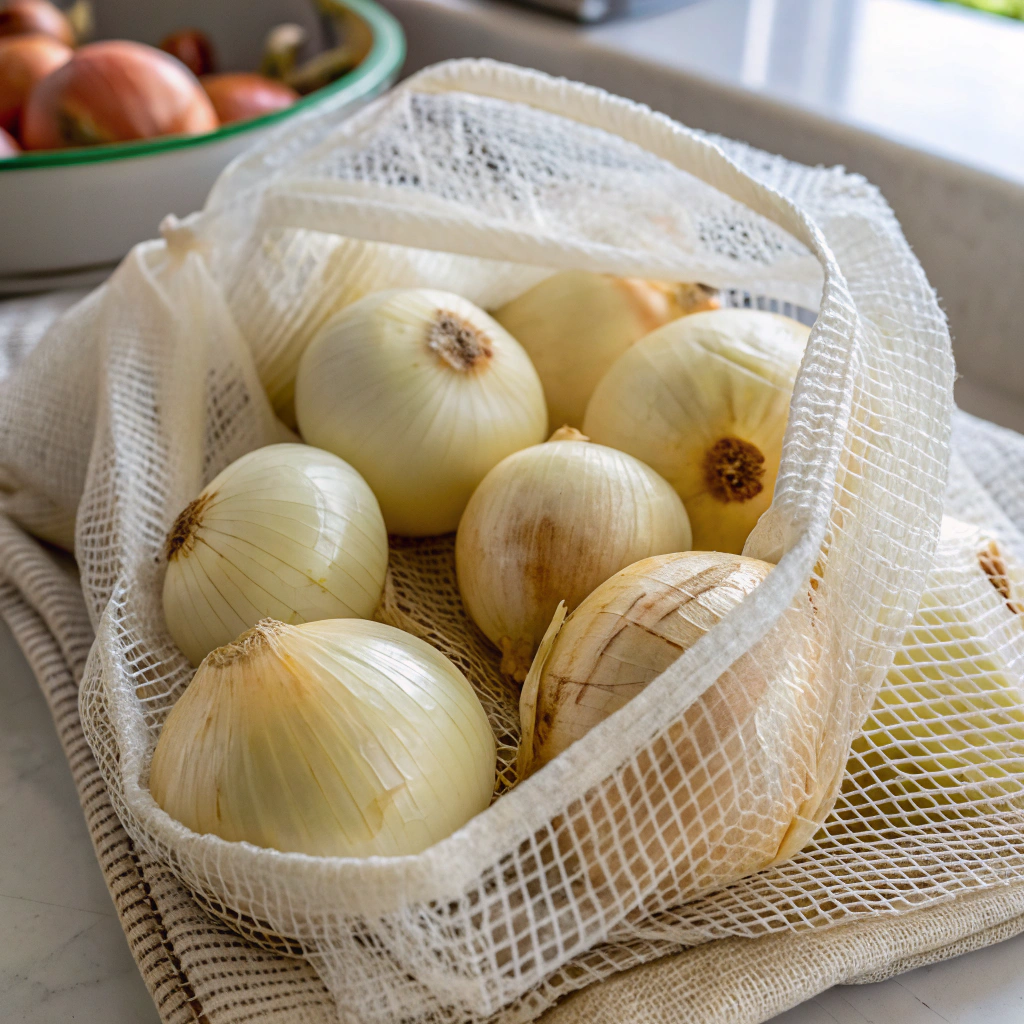
Let’s tackle those pesky onion storage issues head-on! First, check your onions daily for any soft spots or green shoots. The moment you spot sprouting, it’s time to use that onion pronto. For optimal freshness, store whole onions in a single layer – stacking creates pressure points that lead to rot.
Those mesh produce bags from the grocery store? Perfect for hanging onions! The airflow prevents moisture buildup while keeping them organized. Here’s a pro tip: trim off the roots, but leave that papery skin intact – it’s nature’s protective wrapper. If you notice one onion starting to turn, remove it immediately.
Remember that old saying “one bad apple spoils the bunch”? Same goes for onions! For the longest shelf life, aim for consistent temperatures around 40-45°F and keep those bulbs bone-dry.
Alternative Storage Methods
Let’s explore some creative ways to store onions when traditional methods aren’t an option! Those old pantyhose from the back of your drawer? Perfect for onion storage – just drop them in one at a time, tying knots between each. For apartment dwellers, try hanging a wire basket from your ceiling – it saves counter space while keeping air flowing.
If you’re short on space, repurpose paper coffee filters by wrapping individual onions – they’re breathable and prevent moisture buildup. Another genius hack: punch holes in a cardboard box and line it with newspaper. The holes provide ventilation while the paper absorbs excess moisture.
For small quantities, brown paper bags work wonders – just roll the top down and store in a cool spot. Remember to label everything with dates using a marker, making rotation a breeze.
Temperature and Humidity Control
Want perfect onions that last for months? Temperature and humidity are your secret weapons. Keep those tear-jerking beauties between 40-50°F – any colder and they’ll get mushy, warmer and they’ll sprout faster than weeds! Aim for around 65-70% humidity, which might sound technical but just means a cool, dry spot with good airflow.
Basements work great, but a garage or unused closet can do the trick too. Avoid storing near potatoes – they’re like that friend who brings out the wild side in everyone, making onions sprout early!
Check your stash weekly for any soft spots or sprouting. One bad onion can spoil the bunch faster than you’d think. If you spot any starting to go, just move them to your cooking queue. And remember, darker spots tend to stay cooler, so that shady corner of your pantry might be perfect!
Creative Storage Methods & Solutions
Traditional Root Cellar Techniques

Want to master the art of onion storage like our grandparents did? Root cellars were their secret weapon, and we can adapt those time-tested methods for modern homes. Create a mini root cellar using a wooden crate lined with newspaper in your basement or garage.
The key is layering your onions carefully – never stack them more than two deep, and space them so they’re not touching. For the best results, use paper bags with punched holes or mesh bags to maximize airflow. Got a spare closet? Transform it into an onion storage haven by installing a small fan for circulation.
Remember to check your onions weekly and remove any that show signs of softening. These old-school techniques work brilliantly with our Mediterranean Chickpea Salad when you need perfectly stored onions for fresh recipes.
Modern Storage Solutions & Gadgets
Today’s kitchens offer exciting new ways to store onions while maintaining that farm-fresh flavor. Smart storage containers with adjustable ventilation are game-changers – look for ones with dark-tinted bases and perforated lids.
Those mesh produce bags from the grocery store? Give them new life by hanging them from under-cabinet hooks for perfect airflow. Got a spare kitchen drawer? Transform it into an onion sanctuary by adding bamboo dividers and drilling small ventilation holes. The coolest trick? Repurpose those terra cotta pots from your garden – flip them upside down, place onions inside, and cover with their saucer for a natural humidity control system.
Remember to keep your onions away from potatoes and apples, as they’ll make each other spoil faster. For tech-savvy cooks, smart food storage sensors can now monitor humidity and alert you when conditions aren’t optimal.
Traditional Storage Methods That Stand The Test of Time
Long before modern gadgets, our grandparents knew exactly how to store onions properly. The key? A cool, dark, and well-ventilated space around 40-50°F. Those old-school brown paper bags? They’re perfect – just punch a few holes for airflow and roll the top down.
Braiding onions isn’t just for show; this age-old technique allows proper air circulation while keeping them organized. Root cellars were onto something – the consistent temperature and darkness can keep onions fresh for months. A wooden crate lined with newspaper works wonders, especially in a basement corner.
Just remember the golden rule: keep those onions dry! Even a little moisture can trigger sprouting. And here’s a fun old-timer’s trick: slip a pair of clean pantyhose over your onions, tie knots between each one, and hang them up. Sounds weird, but it works like a charm!
Start Storing Your Onions Today
Ready to become an onion storage pro? Put these tips into action right now! Grab a mesh bag, find that perfect cool spot, and start organizing your onions today. You’ll save money, reduce waste, and always have fresh onions on hand for your favorite recipes. Remember, good storage means better-tasting meals all year round!





